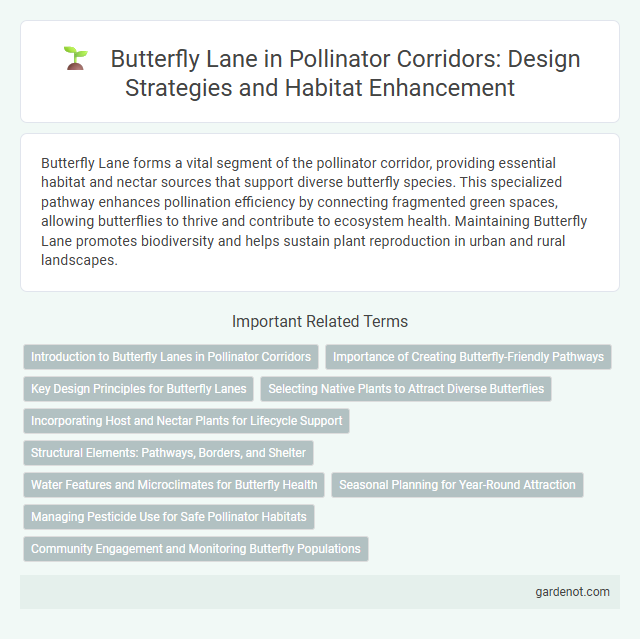Butterfly Lane forms a vital segment of the pollinator corridor, providing essential habitat and nectar sources that support diverse butterfly species. This specialized pathway enhances pollination efficiency by connecting fragmented green spaces, allowing butterflies to thrive and contribute to ecosystem health. Maintaining Butterfly Lane promotes biodiversity and helps sustain plant reproduction in urban and rural landscapes.
Introduction to Butterfly Lanes in Pollinator Corridors
Butterfly lanes are essential components of pollinator corridors, designed to create continuous habitats that support butterfly populations by providing native flowering plants and host species. These lanes enhance biodiversity by facilitating butterfly movement and feeding, contributing to the health of ecosystems and agricultural productivity through improved pollination. Integrating butterfly lanes into urban and rural landscapes mitigates habitat fragmentation and promotes sustainable environmental stewardship.
Importance of Creating Butterfly-Friendly Pathways
Creating butterfly-friendly pathways enhances pollinator biodiversity by providing essential nectar sources and larval host plants that support various butterfly species throughout their life cycles. These corridors improve habitat connectivity, enabling butterflies to migrate, breed, and feed safely amid urban and agricultural landscapes. Establishing butterfly lanes contributes crucial ecosystem services such as pollination, which supports plant reproduction and overall environmental health.
Key Design Principles for Butterfly Lanes
Butterfly lanes prioritize native flowering plants that provide continuous nectar sources throughout butterfly life cycles, enhancing habitat connectivity for pollinators. These corridors utilize layered vegetation structures to offer shelter, roosting sites, and breeding grounds, supporting diverse butterfly species. Strategic placement along migratory paths ensures effective pollinator movement and biodiversity conservation within urban and rural landscapes.
Selecting Native Plants to Attract Diverse Butterflies
Selecting native plants for a butterfly lane enhances pollinator corridor effectiveness by providing essential nectar sources and larval host plants specific to local butterfly species. Native plants such as milkweed, coneflowers, and goldenrod support a wide range of butterflies by offering optimal food and habitat conditions. Integrating diverse native flora promotes ecological balance, increases butterfly diversity, and sustains healthy pollinator populations.
Incorporating Host and Nectar Plants for Lifecycle Support
Butterfly Lane enhances pollinator corridors by strategically incorporating host plants like milkweed and nectar plants such as coneflowers, ensuring critical resources for butterfly lifecycle stages. These diverse plantings provide essential habitats for egg-laying, caterpillar nourishment, and adult butterfly feeding, promoting population sustainability. Integrating native species tailored to local butterfly populations maximizes ecological impact and supports overall biodiversity.
Structural Elements: Pathways, Borders, and Shelter
Butterfly Lane incorporates winding pathways designed from permeable materials to support water drainage and prevent soil erosion, enhancing habitat quality for pollinators. Borders are planted with native flowering species such as milkweed and coneflowers, providing essential nectar sources while defining the corridor's edges. Strategic placement of natural shelters, including dense shrubs and log piles, offers protection and overwintering sites critical for butterfly life cycles and other pollinators.
Water Features and Microclimates for Butterfly Health
Water features in Butterfly Lane create essential hydration points that support butterfly feeding and breeding behaviors. Varied microclimates, shaped by strategic planting and shading, provide butterflies with optimal temperatures for wing thermoregulation and nectar foraging. These environmental elements enhance butterfly health and biodiversity within pollinator corridors.
Seasonal Planning for Year-Round Attraction
Butterfly Lane's seasonal planning incorporates a diverse selection of native flowering plants that bloom sequentially from early spring to late fall, ensuring continuous nectar sources for pollinators such as monarchs, swallowtails, and skippers. Strategic planting schedules align with local climate patterns and butterfly life cycles to maximize habitat availability and support breeding throughout the year. Integrated use of host plants like milkweed and nectar-rich flowers fosters sustained pollinator activity, making Butterfly Lane a vital corridor for seasonal butterfly migration and biodiversity conservation.
Managing Pesticide Use for Safe Pollinator Habitats
Managing pesticide use along the Butterfly Lane is critical for creating safe pollinator habitats that support diverse butterfly populations. Employing integrated pest management techniques minimizes harmful chemical exposure while preserving native flora essential to butterfly life cycles. Strict regulation and community education promote sustainable practices that protect pollinator health and enhance biodiversity.
Community Engagement and Monitoring Butterfly Populations
Butterfly Lane serves as a vital pollinator corridor that actively engages local communities through citizen science programs and educational workshops, fostering awareness about butterfly conservation. Continuous monitoring of butterfly populations along the lane utilizes data collected by volunteers to track species diversity and population trends, informing habitat management strategies. This community-driven approach enhances biodiversity while promoting stewardship of local ecosystems.
Butterfly lane Infographic

 gardenot.com
gardenot.com